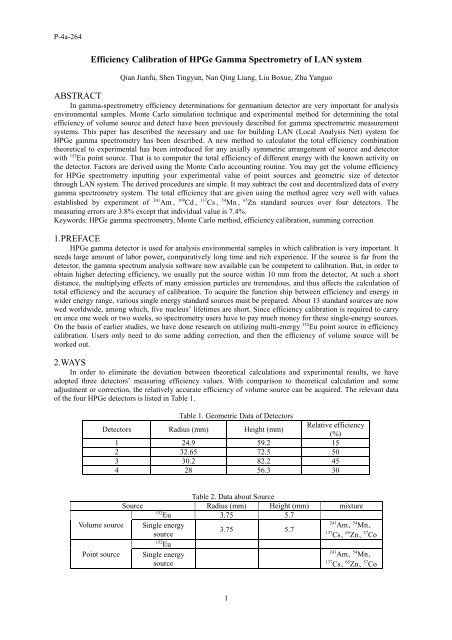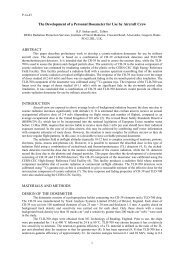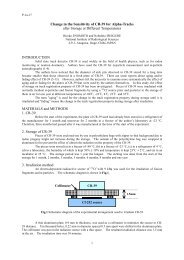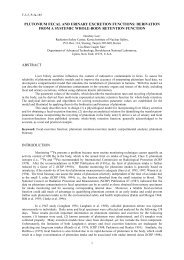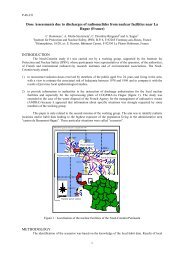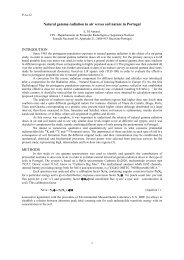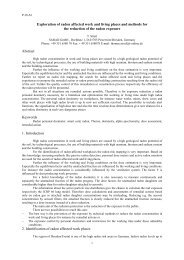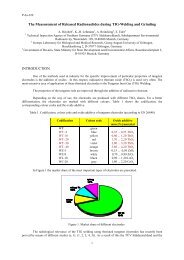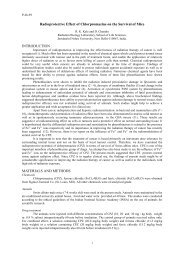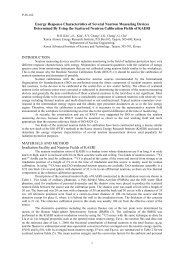Efficiency Calibration of HPGe Gamma Spectrometry of LAN system
Efficiency Calibration of HPGe Gamma Spectrometry of LAN system
Efficiency Calibration of HPGe Gamma Spectrometry of LAN system
Create successful ePaper yourself
Turn your PDF publications into a flip-book with our unique Google optimized e-Paper software.
P-4a-264<br />
<strong>Efficiency</strong> <strong>Calibration</strong> <strong>of</strong> <strong>HPGe</strong> <strong>Gamma</strong> <strong>Spectrometry</strong> <strong>of</strong> <strong>LAN</strong> <strong>system</strong><br />
Qian Jianfu, Shen Tingyun, Nan Qing Liang, Liu Boxue, Zhu Yanguo<br />
ABSTRACT<br />
In gamma-spectrometry efficiency determinations for germanium detector are very important for analysis<br />
environmental samples. Monte Carlo simulation technique and experimental method for determining the total<br />
efficiency <strong>of</strong> volume source and detect have been previously described for gamma spectrometric measurement<br />
<strong>system</strong>s. This paper has described the necessary and use for building <strong>LAN</strong> (Local Analysis Net) <strong>system</strong> for<br />
<strong>HPGe</strong> gamma spectrometry has been described. A new method to calculator the total efficiency combination<br />
theoretical to experimental has been introduced for any axially symmetric arrangement <strong>of</strong> source and detector<br />
with 152 Eu point source. That is to computer the total efficiency <strong>of</strong> different energy with the known activity on<br />
the detector. Factors are derived using the Monte Carlo accounting routine. You may get the volume efficiency<br />
for <strong>HPGe</strong> spectrometry inputting your experimental value <strong>of</strong> point sources and geometric size <strong>of</strong> detector<br />
through <strong>LAN</strong> <strong>system</strong>. The derived procedures are simple. It may subtract the cost and decentralized data <strong>of</strong> every<br />
gamma spectrometry <strong>system</strong>. The total efficiency that are given using the method agree very well with values<br />
established by experiment <strong>of</strong> 241 Am、 109 Cd、 137 Cs、 54 Mn、 65 Zn standard sources over four detectors. The<br />
measuring errors are 3.8% except that individual value is 7.4%.<br />
Keywords: <strong>HPGe</strong> gamma spectrometry, Monte Carlo method, efficiency calibration, summing correction<br />
1.PREFACE<br />
<strong>HPGe</strong> gamma detector is used for analysis environmental samples in which calibration is very important. It<br />
needs large amount <strong>of</strong> labor power, comparatively long time and rich experience. If the source is far from the<br />
detector, the gamma spectrum analysis s<strong>of</strong>tware now available can be competent to calibration. But, in order to<br />
obtain higher detecting efficiency, we usually put the source within 10 mm from the detector, At such a short<br />
distance, the multiplying effects <strong>of</strong> many emission particles are tremendous, and thus affects the calculation <strong>of</strong><br />
total efficiency and the accuracy <strong>of</strong> calibration. To acquire the function ship between efficiency and energy in<br />
wider energy range, various single energy standard sources must be prepared. About 13 standard sources are now<br />
wed worldwide, among which, five nucleus’ lifetimes are short. Since efficiency calibration is required to carry<br />
on once one week or two weeks, so spectrometry users have to pay much money for these single-energy sources.<br />
On the basis <strong>of</strong> earlier studies, we have done research on utilizing multi-energy 152 Eu point source in efficiency<br />
calibration. Users only need to do some adding correction, and then the efficiency <strong>of</strong> volume source will be<br />
worked out.<br />
2.WAYS<br />
In order to eliminate the deviation between theoretical calculations and experimental results, we have<br />
adopted three detectors’ measuring efficiency values. With comparison to theoretical calculation and some<br />
adjustment or correction, the relatively accurate efficiency <strong>of</strong> volume source can be acquired. The relevant data<br />
<strong>of</strong> the four <strong>HPGe</strong> detectors is listed in Table 1.<br />
Table 1. Geometric Data <strong>of</strong> Detectors<br />
Detectors Radius (mm) Height (mm)<br />
Relative efficiency<br />
(%)<br />
1 24.9 59.2 15<br />
2 32.65 72.5 50<br />
3 30.2 82.2 45<br />
4 28 56.3 30<br />
Table 2. Data about Source<br />
Source Radius (mm) Height (mm) mixture<br />
152 Eu 3.75 5.7<br />
Volume source Single energy<br />
241 Am、 54 Mn、<br />
3.75 5.7<br />
source<br />
137 Cs、 65 Zn、 57 Co<br />
Point source<br />
152 Eu<br />
Single energy<br />
source<br />
241 Am、 54 Mn、<br />
137 Cs、 65 Zn、 57 Co<br />
1
P-4a-264<br />
To make it easy operational, we have written a program to compute the peak efficiency, including Monte<br />
Carlo method. Users only need to measure the spectrum data <strong>of</strong><br />
152 Eu and<br />
137 Cs point source in two different<br />
positions (one is where coincidence summing effects can be neglected, for example, 25cm far away; another is at<br />
the same height with the volume source), next input the corresponding values according to the flow chart, and<br />
then users can get the summing correction factor <strong>of</strong> their 152 Eu point source. Following the flow chart, input the<br />
relevant parameters <strong>of</strong> source and detector to obtain theoretical efficiency <strong>of</strong> 152 Eu point source. In the end, the<br />
efficiency curve <strong>of</strong><br />
152 Eu volume source at every energy can be established through transmission method.<br />
The flow chart <strong>of</strong> calibrating volume source:<br />
Measure spectrum data <strong>of</strong> 152 Eu and 137 Cs point source at 25cm and 7cm away<br />
Calculate the value <strong>of</strong> ku、 Ku(Cs)<br />
Calculate the coincidence adding factor <strong>of</strong> users detector’s 152 Eu point source<br />
Compute theoretical efficiency values <strong>of</strong> volume source and point source with program<br />
Establish transmission efficiency carve <strong>of</strong> 152 Eu point source<br />
Insert efficiency value at cared energy<br />
2.1THEORETICAL CALCULATION<br />
The theoretical efficiency <strong>of</strong> point source and volume source are obtained through Monte Carlo method,<br />
which is also called Random Sampling or Statistical Experiment method. It transfers the solving <strong>of</strong> problems<br />
into seeking for the expected value or statistical average value, that is to say, simulating physical experiment<br />
with mathematical means. According to the flow chart, input the needed data and compute the interaction<br />
efficiency between photons and crystal after the emission photons arrive at the crystal.<br />
Table 3. The K value <strong>of</strong> three measuring <strong>system</strong><br />
Energy(Kev) NO.1 NO.2 NO.3 The average value <strong>of</strong> K<br />
121.78 0.8372 0.8049 0.8887 0.8436<br />
244.69 0.9209 0.9198 0.9718 0.9375<br />
344.28 0.9798 0.9703 1.0067 0.9856<br />
443.98 0.9511 0.9656 0.9897 0.9688<br />
778.9 0.9665 0.9863 0.9846 0.9791<br />
964 1.021 1.045 1.0037 1.0232<br />
112.13 0.9722 0.9355 0.9891 0.9656<br />
1408.03 1.0153 1.0447 1.0149 1.025<br />
Table 4. The standard Laboratory coincidence Adding Factors<br />
Energy 121.8 224.7 344.3 443.9 778.9 964 1112.1 1408.0 661.6<br />
(Kev)<br />
Ku 8.831 8.262 8.256 7.976 8.007 7.957 7.976 7.916 8.457<br />
Ccu 1.094 1.17 1.129 1.109 1.037 1.037 1.037 1.042<br />
2
P-4a-264<br />
2.2 COMBINING THEORETICAL CALCULATION WITH EXPERIMENTS<br />
Combining the theoretical calculation with experimental established efficiency, we can get:<br />
K 1 =ε vm /ε pm (1)<br />
K 1 =ε vc /ε pc (2)<br />
K = K 1 /K 2 (3)<br />
where, ε vm is the actually measured peak efficiency <strong>of</strong> volume source, ε pm is the actually measured peak<br />
efficiency <strong>of</strong> point source, ε vc is the calculated peak efficiency <strong>of</strong> volume source, and ε pc is the calculated<br />
peak efficiency <strong>of</strong> point source.<br />
In user’s measuring <strong>system</strong>, obtaining volume source’s efficiency requires to carry on the fourth formula<br />
ε v =ε pm * K 2 * K (4)<br />
where, εv is the peak efficiency <strong>of</strong> volume source calculated with transmission method.<br />
From the fourth formula we can see, users can get the comparatively accurate efficiency <strong>of</strong> volume source<br />
if combining the actually measured volume efficiency with the k value provided in the program.<br />
3.EXPERIMENTS<br />
We have carried on research and calculation in three p-type <strong>HPGe</strong> gamma spectrometry <strong>system</strong>s which<br />
have different parameters and efficiency, and the relative peak efficiency at the energy <strong>of</strong> 1.332Mev is 15%、<br />
20% and 45%respectibely. The distance between the point source and the front end <strong>of</strong> the detector is 7cm.<br />
The volume source is a plastic, cylinder-shaped, basic substance source, which is placed at the front and <strong>of</strong><br />
the detector. The adopted radioactive nucleus are 241 Am、 109 cd、 57 co、 137 cs、 54 Mn、 65 Znand 152 Eu,and we’ve<br />
collected the spectrum data <strong>of</strong> every single-energy point source and volume source listed above. A66 spectrum<br />
analysis s<strong>of</strong>tware from American’s ORTEC Company has been applied to analyses peak parameters.<br />
Considering the adding correction factor <strong>of</strong> 152 Eu when ding analysis, we have achieved a set <strong>of</strong> k values. In the<br />
end, the efficiency curve has been testified on the fourth detector (the relative efficiency is 30% at the energy <strong>of</strong><br />
1.332Mev) and the results are listed in figure 5. Except for the deviation <strong>of</strong> ±7.4^at the energy point <strong>of</strong> 122.06<br />
Kev, deviations at another five energy points are all within the range <strong>of</strong> ±3.8%.<br />
Table 5. Comparison <strong>of</strong> volume source’s activity on the four detector<br />
nucleus Energy<br />
standard source activity As measured activity Am<br />
(Bq)<br />
(Bq)<br />
(Am-As)/As<br />
241 Am 59.54 4825.241 4619.567 -0.04262<br />
109 Cd 88.03 2586.093 2625.295 0.01516<br />
57 Co 122.06 103.37 111.0257 0.07406<br />
57 Co 136.2 103.37 107.392 0.03891<br />
137 Cs 661.66 692.93 698.8345 0.00852<br />
54 Mn 834.83 211.515 215.599 0.01931<br />
65 Zn 1115.52 271.39 269.622 -0.00651<br />
4.CONCLUSION<br />
Calibrating peak efficiency <strong>of</strong> volume source in the way described above can solve the problem <strong>of</strong> in<br />
sufficient single energy. Some computers can be connected to form a pc net for exchanging information and<br />
sharing resources. With the measured efficiency value <strong>of</strong> 152 Eu point source (having been carried on coincidence<br />
adding correction), considering the k value provided by the net’s general station and doing simple simulation<br />
calculation with Monte Carlo method, we can achieve the efficiency calibration <strong>of</strong> volume source easily. The<br />
statistical error <strong>of</strong> peak efficiency is 1%. It takes 90 minutes to run the program on 386 computer, so minutes on<br />
486 computer and 15 minutes on 586 computer.<br />
3
P-4a-264<br />
PC work station<br />
Pc work station<br />
PC (net)general station or VAX<br />
Providing services for files and disks<br />
<strong>Gamma</strong><br />
<strong>system</strong><br />
spectrometry<br />
Other parts <strong>of</strong><br />
the net<br />
<strong>Gamma</strong> spectrometry<br />
<strong>system</strong><br />
5.DISCUSSION<br />
For the energy beyond 136kev, the measured values agree well with the transmission values <strong>of</strong> total<br />
efficiency, while at the energy <strong>of</strong> 122kev, the error ix 7.8%. The reason is complicated and many-sided, such as<br />
the statistical counting error and inaccuracy <strong>of</strong> the standard source’s activity provided.<br />
Precise calculation <strong>of</strong> the total efficiency <strong>of</strong> cylinder-shaped volume source, as well as fast running and<br />
other advantages, depend heavily on the personal computer. Besides, the self-absorption factor and adding<br />
correction factor are rather important in efficiency calibration. In environmental samples, the self-absorptions <strong>of</strong><br />
sample’s density within wide range are quite different, but the method we’ve introduced is really used. Users<br />
only need to measure the standard point source and some fixed data, such as detector’s parameters and trans<br />
mission parameter. So, this method is suitable for point source and other volume sources.<br />
If possible, we will evaluate the method on more users' detectors, and that maybe provide better result for<br />
our work..<br />
REFERENCES<br />
1.Gerhard Haase, David Tait and Arnold Wiechen, Application <strong>of</strong> a new Monte Carlo method for<br />
determination <strong>of</strong> summation and Self-attenuation corrections in gamma spectrometry. Nucl. Lnstr. And Meth in<br />
phys. Res. A 336 C (1993) 206-214<br />
2.I. Ramos-Lerate, M.Barrera, R・A・Ligero, M・Casas Ruis A mew Summing—correction method for<br />
gamma-efficienag calibration with multi-gamma-ray radionuclides. Nucl. Instr. And Meth. In Phys<br />
・Res.A395(1997)202-206.<br />
3.B.Lalang K・V・K・Lyengar, Nucl. Instr. And Meth. 79(1970) 19<br />
4.T・Gozani, Nucl.instr.and Meth. B56-57 (1991) 829-833<br />
5.Yang Chaoweh, Wu MaoLiang, Nucl. Tech, Vol.11No.5 1988 37-40<br />
6.XU Zhongji, Monte carlo method, 1985.<br />
4


